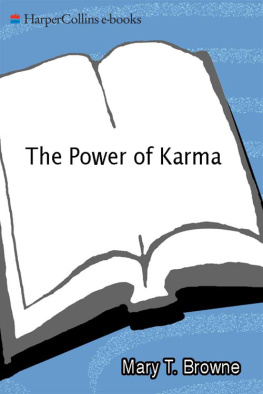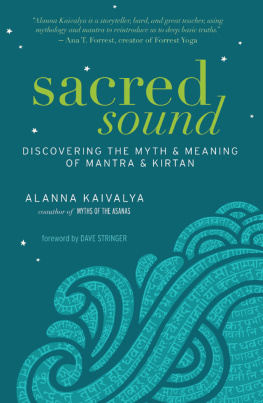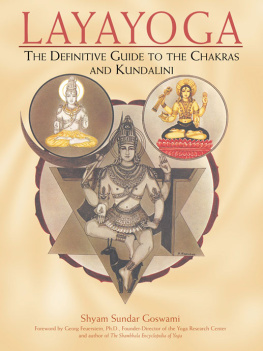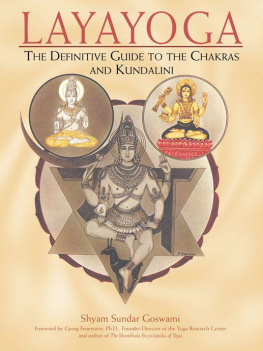Liz Williams, my agent and friend, has my gratitude for her insightful advice on a variety of projects. This book is really her doing from beginning to end. Thank you so much, Liz. But it would also not be completed with such attention to detail without the care of Sounds True producer and editor Randy Roark. I am grateful for his commitment to quality and the ease he creates in the process.
There are people who contribute in quiet, but extremely important ways. First, my wife, Margalo, can take credit for all the books and audio products I have been able to complete. Without her support in a variety of ways, it is improbable that I would have written any books at all. Her love is an ongoing inspiration. Joseph Morales, my webmaster, has contributed countless hours of page design, graphic design, and schedule posting for sanskritmantra.com. In fact, the website was his original idea. In 1996, I had no idea what a website was. I am very, very grateful. I also want to express my gratitude to Theresa Van Zante of WMS Media for her skillful and tireless publicity work, of which I have been the happy recipient.
Lastly, of course, my late spiritual teacher and benefactor, Sadguru Sant Keshavadas, who told me many years ago that I would be writing books and teaching. I am amazed as well as more grateful than I can adequately express. His widow, Guru Mata, continues his spiritual work with great humility. Fortunate are we who can spend time with her now and then.
Introduction
We are custodians of great power, but we do not think about it or sometimes even believe it. To most of us, power is something that exists outside of ourselves, and no one seems to have control over the events and conditions of his or her life. It can be an internal condition, a relationship, a chain of events, an organization ... there is always something out of our control.
Complicating matters, there is little in the way of reference materialspiritual or otherwisethat explains what tangible, accessible power really is or how to get it. To be sure, there are many self-help books that show us how to control our habits, and develop new and better ones. There are also books that instruct us how to communicate more effectively, and build better personal and business relationships. But nowhere are there clearly defined and explained texts that tell us how we can have an immediate, powerful effect on our environment through the application of some kind of personal force.
In the West, we are not at all accustomed to the idea of having a personal force or power. We are well aware of the power of government and other institutions. We respect and even admire the brute force of machines that power our economy. We are all becoming better informed through the power of mass media, but it, more than anything else, can convince us that real power lies outside of us. In fact, in the West we are faced with a de facto conditioning that all power is really external to the individual. Part of the lure of the computer is that it increases our sense of personal power and our impact on the world, though for all of its tremendous advantages, it is still external.
In the East, the idea of personal power has been commonly accepted for centuries. It is a paradox that, while there is great poverty in many Eastern nations, there is also a history and legacy of great spiritual power, from Rama, Krishna, the Buddha, and others. Like Western religious leaders, these Eastern figures stated clearly that whatever they have attained, we can also attain. There are, of course, many different methods taught for accumulating personal power for spiritual and material advancement. The one that has been taught to me and that I present in this book is mantra meditation.
Mantra meditation is not only something one practices, but a radical re-envisioning of ourselves, our lives, and our ability to create the future we desire. The principles of mantra meditation are based on a classical Eastern model of how the universe operates, and our place and purpose in it. In this model, the universe is composed of energy, and the most important thing we can do in order to manifest the kind of life we want is to tap into that energy, specifically in this case through the power of sound.
Through the application of Sanskrit spiritual formulas, energy comes into our body that dissolves our difficulties and improves our lives. Over time, sometimes many lives, our karmawhich is a term I discuss in more detail a bit laterbecomes exhausted, and we become spiritually free of any worldly bondage. Then we are presented with a new set of options as evolving entities.
Among the many mantras that have been recorded by sages and mystics, some of which have come to the West, I have selected and categorized a few that are the most useful in pursuing the classical Eastern aims of human existence: prosperity, worldly desires, ethical and noble development, and spiritual fulfillment leading to liberation. Those goals are explained in subsequent chapters, but for now, know that with mantras you can begin to shape the outer manifestations of your life.
So powerful are these ancient tools that they were intentionally hidden by the Brahman priesthood for centuries. It is only in the last century that the lid has come off, and teachers have come from India and Tibet to share their spiritual wealth with students in the West, many of them the teachers former students from previous lives. Collectively, this spiritual work will ultimately reshape the planet, but in the short term, you can fulfill some of your most cherished desires and have a better life.
Mantra meditation is not magic, but the results can be magical. Through the practice of a daily discipline that is simple and easy to usecustomarily over a period of forty daysanyone can learn how to organize some of the fundamental energies of the universe to directly affect his or her specific concerns.
People have healed themselves or family members using mantra as a tool to guide them to proper health practitioners and methods. New relationships have appeared, satisfying long-standing desires. Better jobs have been secured, raises obtained, and working conditions improved, all by harnessing the great power in Sanskrit mantras that activates the dynamic forces within each and every one of us.
In this program, I have collected some of the most popular and effective mantras, and presented them in such a way that you can begin practicing mantra meditation immediately. You do not have to travel to India, become a monk, or change your religion in order to come to a new understanding of the basic principles of causality and to use them to get the results you desire.
I have also included a chapter on a space-cleansing feng shui mantra from the Chinese system for organizing the space environments in our lives for maximum benefit. Some have suggested that feng shui derives from the ancient Hindu science of Vastu. Certainly the underpinning philosophies are nearly identical, but there are functional differences, just as there are among various schools of feng shui. When I met feng shui master Nathan Batoon, I was struck by his humility as well as his expertise. He and I share a connection through the Vajrayana branch of Tibetan Buddhism, so the type of feng shui from which I have selected this mantra is called Black Hat (Vajrayana-based) feng shui. Since we all live and work in various environments, I thought it important to include a mantra that would cleanse the spaces you inhabit.
Before you can most successfully practice mantra meditation, you need to understand some of the important principles of this system. Thus, the first section of this program lays groundwork for your practice by explaining the basic principles underlying the use of mantras. This includes an introduction to some of the forces of this system as personified in the Hindu pantheon of gods and goddesses, because most of the mantras you will be using will be directed to these figures, who are included in the classical Eastern scriptures from which these mantras have been preserved.










